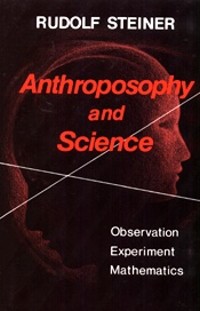Anthroposophy and Science
GA 324

Rudolf Steiner examines the underlying precepts of the modern scientific approach and its current tools of observation of nature, experimentation, and the use of mathematics to establish quantitative relationships which are then framed as laws. He relates the validity of this approach for examination of the lifeless mineral realm and then describes the different cognitive states that are necessary to scientifically examine the realms of the living and of the conscious.
Anthroposophy and Science was publish in German as, Naturbeobachtung, Experiment, Mathematik und die Erkenntnisstuffen der Geistesforschung. This translation was done by Walter Stuber and Mark Gardner, and was edited by Gladys Hahn and Gerald Karnow, M.D. The cover was designed by Maryann Perlman.
| Introduction | ||
| Lecture I | March 16, 1921 | |
| The three forms of science. Observation of nature, experiment and mathematical penetration of nature. The nature of the experiment. The certainty of mathematical knowledge. Psychology then and now. Growth in boys and girls. The customary cognition of nature. The philosophy of David Hume. Mathematical cognition as an inner constructive activity. Spiritual cognition as an inner activity encompassing reality. | ||
| Lecture II | March 17, 1921 | |
| The membering of man into nerve-sense system, rhythmical system of feeling and metabolic-will system as described in the book Riddles of the Soul. The inner nature of vision, arm-movement and walking in relation to the three dimensions of space. | ||
| Lecture III | March 18, 1921 | |
| The possibility of explaining nature out of itself and the super-sensible world. Normal and mathematical nature knowledge. The application of mathematical cognition to the mineral, dead world; attaining an apprehension of the plant world through imaginative cognition. The two kinds of clairvoyance. The theory of the subjectivity of sense perception. The duality of the eye as a physical apparatus and an organ streamed through by life. The discovery of the etheric body through imagination. The application of this view to the whole human being. The longing for an expansion and a deepening of our cognition. | ||
| Lecture IV | March 19, 1921 | |
| Imagination as mode of cognition for the world of life. Gustav Theodor Fechner. Acquiring the imaginative method. The nerve-organization as synthetic sense-organ. Concerning the intellect. Memory and Imagination. Love as help in strengthening the capacity to forget. Self-discipline as enhancement of cognitive powers. The image character of mental representation. The flowing of reality into the mental image through Inspiration. | ||
| Lecture V | March 21, 1921 | |
| Modern sense-physiology and the twelve senses. The neurologist Meynert. Controversy in the Giordano Bruno Association concerning mental imaging. Theodor Ziehen's psychology. Analytic and synthetic (projective) geometry. Moriz Benedikt and mathematics. Inspirational cognition of the rhythmic system. The Yoga system. The nature of symbolism. The psychological origin of cultic action. The modern intellect. Earlier cultic activity and modern scientific experiment. | ||
| Lecture VI | March 22, 1921 | |
| The memory picture and its transformation in Imagination and Inspiration. The intellect in modern natural science and in Goethe. The phenomenon and the archetypal phenomenon. The enhanced activity of forgetting as experience of inner freedom. From the nature of memory to the cognition of the inner aspects of the human being: liver, kidney. St. Theresa, Mechtild von Magdeburg. The formation of the nervous system. Lectures about “Anthroposophy” in 1909 and the book “Anthroposophy. A Fragment.” The correspondence of one upper and one lower organ in man. Spiritual psychology and therapy. | ||
| Lecture VII | March 23, 1921 | |
| The nature of Intuition. Tumor formation and its healing. Intuition as an inversion of sense-perception. Indefinite perception and dark belief. Life before birth and after death, repeated earth lives. Falling asleep and waking up. The method of writing history. Dante, Luther, Constantine, Julian the Apostate. Concerning the experience of the forces active in history which are not described. Verifying super-sensible facts. The experiment and its consequences for the scientific experience of modern man. Spiritual scientific knowledge as a fructification of the other sciences. | ||
| Lecture VIII | March 23, 1921 | |
| The picture of anthroposophy as the light illuminating a space. The scientific nature of anthroposophy and the social question. The Waldorf School and other institutions originating out of anthroposophy. The necessity of the uniformity of all knowledge. The verification of anthroposophical knowledge. Concerning opponents. Confidence in the academic youth. Admonition to the youth: "Open the shutters!" | ||

